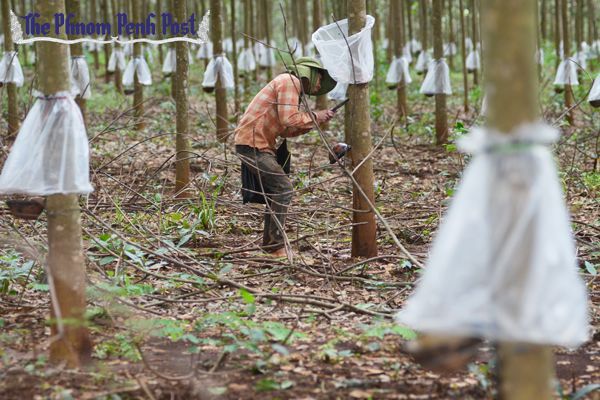Cambodia\’s beleaguered rubber industry looks set for a turnaround as international rubber prices continue their strong rebound. Local traders and industry officials said yesterday they were optimistic that rubber prices, which doubled during the course of 2016, would continue to rise as the global economy recovers and demand driven heavily by developing economies catches up with supply.

A worker taps a rubber tree on a plantation in Ratanakkiri province in 2012. Pha Lina
Pol Sopha, general-director of the rubber department at the Ministry of Agriculture, said local rubber producers exported 148,000 tonnes of natural rubber last year, a 13.5 percent increase on 2015’s output.
However, the average price of these exports last year was just $1,200 per tonne, about $300 lower than in 2015.
Rubber prices dipped to a seven-year low of $1,050 per tonne in March 2016. The latter half of the year, however, saw prices surge to over $2,000 per tonne on China’s improved economic outlook and rising crude oil prices. They have also been buoyed by recent widespread flooding in southern Thailand, a major rubber-producing area.
Locally-produced rubber is currently trading at around $2,170 per tonne, with Sopha confident it still has room to grow.
“It’s a good sign for the rubber sector right now that the price keeps increasing,” he said.
“It’s projected to increase further and could reach $2,500 per tonne this year.”
The automotive industry, which consumes about 70 percent of total rubber production, has remained flat. But rising crude oil prices, which are firming up the price of synthetic rubber, have given natural rubber prices some bounce.
“The price of rubber depends on the price of petrol, so when crude oil prices rise the price of rubber rises as well,” explained Sopha.
He said the improved outlook of rubber was great news for Cambodian farmers, but many did not have the capital to fully exploit the opportunity.
“Currently the price of rubber is good for farmers and profitable, however challenges remain for farmers unable to afford to collect the latex even as prices increase,” he said.
“Most farmers do not have adequate capital to hire workers to tap their trees.”
Men Sopheak, deputy chairman of the Association for Rubber Development of Cambodia, said the ongoing rise in rubber prices has made the cash crop profitable once again. But local producers were not out of the clear just yet.
“We are now satisfied with the price and it has motivated us to continue with rubber farming,” said Sopheak, who also owns a large rubber plantation in Kampong Cham province.
“But it is difficult for us to compete with brokers from neighbouring countries, who buy rubber from local farmers at a higher price.”
He said Cambodian producers could not match these prices because they were bound to paying an export tariff on rubber shipments. A $50 export tax was charged on rubber when the market price was below $2,000 per tonne. Now exporters must pay $150 per tonne.
“The tax payment is still high, and even though we are surviving it is hard to make a profit,” he said.
Thy Sambo, president of the Tbong Khmum Family Rubber Development Association, said most of the association’s members preferred to sell to Vietnamese brokers.
“We are in the free market, and a lot of brokers drive from the border to buy directly from farmers,” he said.
“Since they offer a higher price we are happy to sell to them instead of local buyers.”
Cambodian farmers have planted rubber trees on 431,000 hectares, with 130,000 hectares mature enough for tapping, according to the Ministry of Agriculture.





























